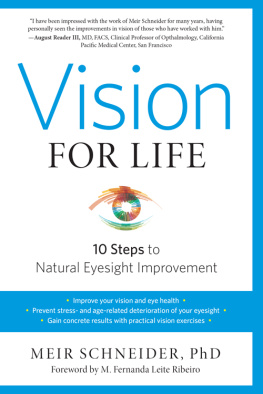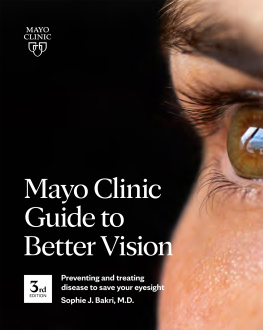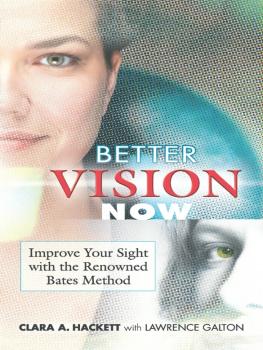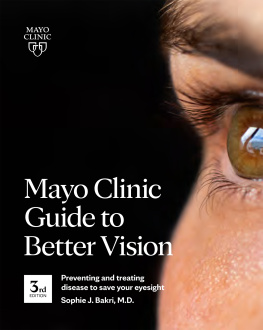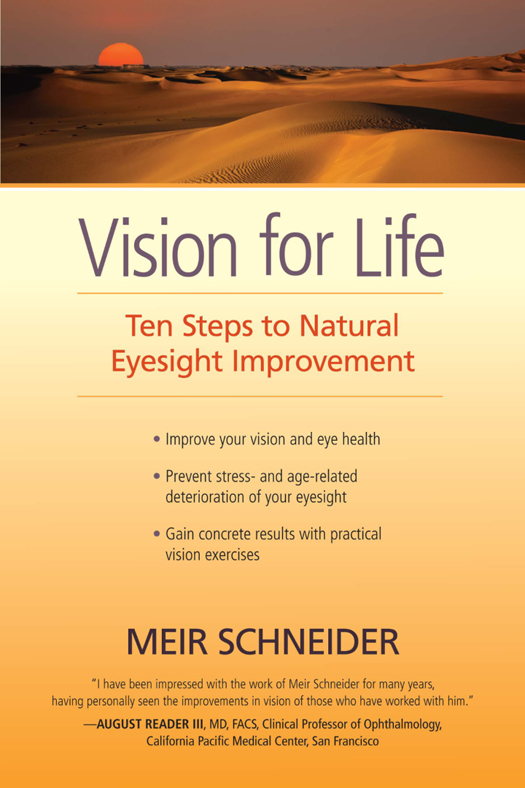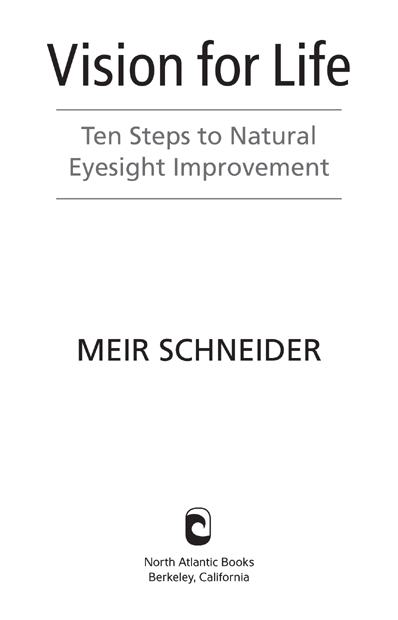Praise for the work of Meir Schneider
As an ophthalmologist, I always search for the best way to treat my patients. Based on the Bates Method, Meir Schneiders self-healing system has complemented my practice in those cases where our traditional medicine has its limitations. The best treatment is the one that is directed to the patients needs, and the best medicine is the one that uses all knowledge and not only a part of it. Traditional science and complementary medicine are tools that should be used together, focusing on a more holistic health concept.
Leonardo Verri Paulino, MD, ophthalmologist and anterior segment surgeon at ABC Medical School, Brazil
Schneiders method is effective as a complementary physical therapy for the eyes.
Emlia Ritsuko Yasuoka Assad, MD, ophthalmologist and acupuncturist, So Paulo, Brazil
Working with my patients has verified that many sight problems get better and heal by taking up the right habits. Meir Schneider presents us with a complete guide to doing so. He helps us to regain our trust in the power we have over our vision and our lives. As he says in the book, We all can take the time. We just have to decide that we are worth the time and that the process is worth our while.
Amelia Salvador, MD, ophthalmologist, Alicante, Spain
It is wonderful how each new book by Meir Schneider provokes us to incorporate more and more of the self-healing principles into our lives.
Laercio Motoryn, MD, ophthalmologist and homeopath, So Paulo, Brazil
The knowledge and application of the self-healing method was very important improving my practice as an ophthalmologist. The results attained by my patients and with my own vision are proof of the importance of the union of traditional medicine with complementary therapies. I thank Meir Schneider for being such a marvelous instrument for my personal and professional improvement.
Ana Cecilia Gois Franco, MD, ophthalmologist and anterior segment surgeon and naturopath, So Paulo, Brazil
I had the pleasure to meet Meir Schneider and use his method when I was finishing my apprenticeship to become a Bachelor of Optometry in 2005. His holistic approach toward visual dysfunctions changed me forever as a professional. His concepts remain present in my appointments, therapies, and lens prescriptions. Schneiders work invites us to naturally preserve our organism and to practice healthier visual habits in this very technological world.
Fernando Nassif, optometrist with specialization in orthoptics and visual therapy, So Paulo, Brazil
There are many kinds of patients, but those who get actively involved with their own healing process can surely go further. When I met Meir Schneider years ago, I started to apply some of his techniques to my work and was impressed by the results. We must imprint our will and optimism into everything we do, so we can go beyond it. Congratulations, Meir, for one more book that brings us simple yet useful lessons.
Mauro Rabinovitch, MD, ophthalmologist, So Paulo, Brazil
Copyright 2012 by Meir Schneider. All rights reserved. No portion of this book, except for brief review, may be reproduced, stored in a retrieval system, or transmitted in any form or by any meanselectronic, mechanical, photocopying, recording, or otherwisewithout the written permission of the publisher. For information contact North Atlantic Books.
| Published by | Cover photo @ istockphoto.com/cinoby |
| North Atlantic Books | Cover design by Suzanne Albertson |
| P.O. Box 12327 |
| Berkeley, California 94712 | Eye charts and red drawings courtesy of Flavio Kauffmann |
Vision for Life: Ten Steps to Natural Eyesight Improvement is sponsored by the Society for the Study of Native Arts and Sciences, a nonprofit educational corporation whose goals are to develop an educational and cross-cultural perspective linking various scientific, social, and artistic fields; to nurture a holistic view of arts, sciences, humanities, and healing; and to publish and distribute literature on the relationship of mind, body, and nature.
North Atlantic Books publications are available through most bookstores. For further information, visit our website at www.northatlanticbooks.com or call 800-733-3000.
MEDICAL DISCLAIMER: The following information is intended for general information purposes only. Individuals should always see their health care provider before administering any suggestions made in this book. Any application of the material set forth in the following pages is at the readers discretion and is his or her sole responsibility.
Library of Congress Cataloging-in-Publication Data
Schneider, Meir, 1954
Vision for life : ten steps to natural eyesight improvement / Meir Schneider.
p. cm.
Summary: Presents ten simple steps to relieve eye strain, correct vision problems, and improve eye health; includes a full range of restorative vision exercisesProvided by publisher.
eISBN: 978-1-58394-515-5
1. Vision disordersTreatment. 2. Visual training. 3. Orthoptics. 4. Bates method of orthoptics. 5. EyeDiseasesTreatment. 6. BlindnessGenetic aspects. I. Title.
RE992.O7S27 2012
617.75dc23
2012011110
v3.1
Contents
Chapter
Healing Myself of Blindness
Chapter
Ten Steps to Better Vision
Chapter
Computer Use and Relieving Built-Up Fatigue
Chapter
Improving and Correcting Errors of Refraction
Chapter
Overcoming Cross-Sightedness and Lazy Eye
Chapter
Pathology Conditions
Chapter
The Blind Spots of Conventional Wisdom
Foreword
W hoever has had the privilege to attend a lecture given by Meir Schneider knows that one does not passively listen to his work. The audience members are immediately treated as students and invited to perform exercises right there in the conference room. According to Meir, more important than talking about his method is experiencing it; theory is only valuable when implemented. We are beings with an incredible adaptive capacity, and so is his teaching: simple, direct, and transformative. It goes beyond the barrier of predefined concepts and comes with the assurance that we can walk away from the passiveness of our routine actions and into the freshness of new ones.
This book is a mirror of his way of teaching. The interactive and dynamic contents express the authors quality, moving us away from the apparent security of restrictive visual habits, to experience new possibilities. Since he considers that we all can improve our vision naturally, this book is not destined only for those who have diagnosed visual dysfunctions; this is for all of us. As Meir always says, routine is the ultimate degenerative disease.
I first met Meir Schneider in 1992, at a conference for six hundred people in So Paulo, Brazil. He made such an impression on the audience that it became the perfect time for the first training course in that country. I took part in it, although I had no previous experience in the health area. To be a health professional was not a prerequisite for Meir, however. He wanted to keep his teaching open to whoever was up to working on himself. This closer contact with the technique completely changed my way of relating to my body and my cognitive processes. Soon I started teaching others, thus complementing my learning experience. A few years later, already working as a fully trained therapist who specialized in visual education, I felt an urge to deepen my theoretical knowledge and went back to school to become an optometrist. This skill gave me better conditions under which to appreciate the grandeur of the methodMeirs great ability to bring complex theory into something that speaks to us. After all, theory tries to explain what we are. And Meir translates it with rare intelligence and generosity. There is no hidden material in his teaching; it is all there, at the reach of minds willing to experience themselves.


